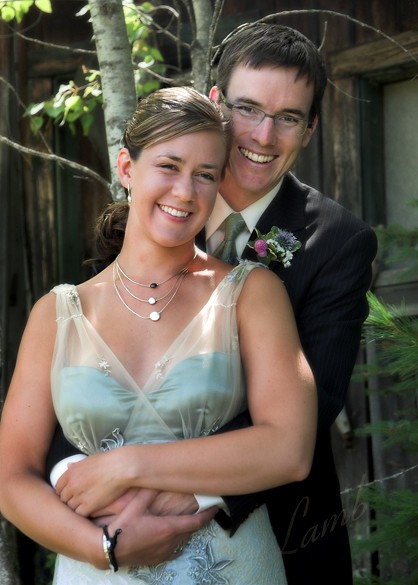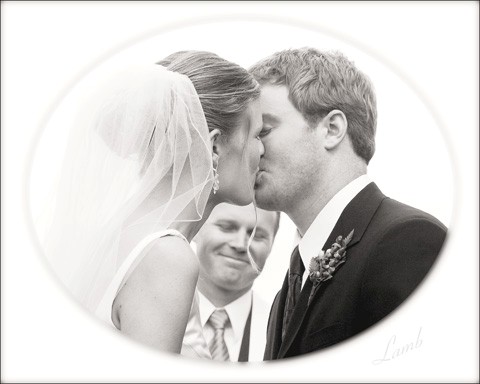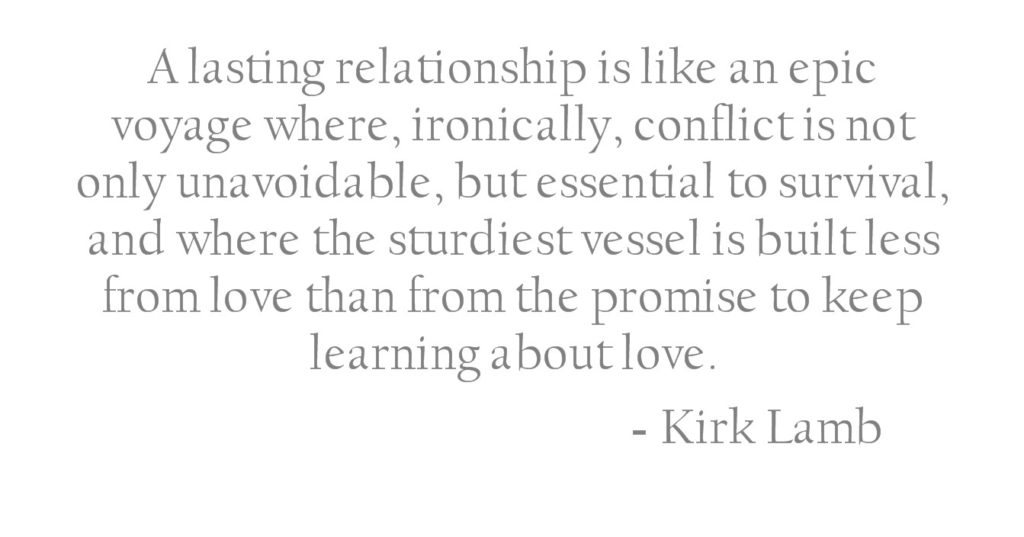
Fellowship of the Rings: Common Sense Wisdom for Lasting Marriages
By: Kirk Lamb, PhD., LP, Licensed Psychologist
© 2005 - 2018 Kirk Lamb, Ph.D., Author, for text, drawings, and photographs
© 2025 Bonnett Chandler, MA, LPCC; Richard Chandler, MA, LPC; Kelly Krueger, MA, LMFT
Note: This marriage and couples relationship e-book is also available as a 40-page booklet for $7.95. If you wish to purchase a copy to give to an engaged couple, simply contact Richard Chandler.
All rights reserved worldwide. Rights of reproduction in any medium are prohibited without the written permission of the publisher.
Author’s Note: Each of the ideas presented in this ebook has something to do with how lasting couples create fellowship and, through it, the emotional safe-haven essential to their success. I will present five of the most powerful tools a couple can employ to create this safe-haven. I have named them “Keepers of the Fellowship”:
- Treat your relationship as if it were your child.
- Face, don’t avoid, conflicts by “getting to the hurt.”
- Avoid financial betrayals every bit as much as romantic betrayals.
- Achieve a healthy “divorce” from families of origin and previous intimate partnerships.
- Support one another’s dreams and respect one another’s deepest dread.
I have based my thoughts on insights from my teachers: my couple clients (over one thousand since 1980), some pioneering marriage and relationship researchers, my professional colleagues, and my wonderful wife, Dee, with whom I have enjoyed a loving fellowship for decades.
A Note About Couples, Marriages and Partners:
The terms “couple,” “spouses,” “marriage,” “partners” and “relationship” will be used somewhat interchangeably throughout the booklet. While there are many meaningful distinctions among these terms, I have chosen to be deliberately imprecise in my effort to present insights that apply to just about all committed long-term relationships. Therefore, much of what I have presented here applies equally well to married and cohabiting couples; opposite-sex and same-sex couples; couples with children and those with none; mixed racial, mixed ethnic and mixed religious couples; and second or third marriage couples.

Common Sense Wisdom for Lasting Couples
By: Kirk Lamb, PhD., LP, Licensed Psychologist
“Marriage is not supposed to make you happy. It’s supposed to make you married; and once you are safely and totally married, then you have a structure of security and support from which you are free to make yourself happy. . . . Marriage is not about being in love. It is about the agreement to love one another. Love is an active, transitive verb. It is something married grownups do no matter how they feel. It is nice when married people are in love with one another, but {when they fall out of love} if they are loving to one another, that magic may catch fire again.”
... Frank Pitman, M.D.
In his best-selling book, “Grow Up,” seasoned couples therapist Dr. Frank Pitman insists that lasting couples must choose to make their relationship a protective structure, one which rests not on love itself, but on an “agreement to love.”
He believes marriage is less about being “in love” than the commitment to learn to love again, every time we fall out of love. When I reflect on the good relationships I have witnessed, I too see couples that have created emotional safe havens within which they repeatedly relearn how to love one another.

‘Fellowship’, Rings and an Emotional Safe Haven
This e-book's title carries a lot of meaning for me. What may first come to mind upon hearing the word, ‘fellowship’ is a community of worshipers bound by shared faith and values, often gathering at the “fellowship hall”. More broadly, a fellowship is commonly assumed to involve caring bonds forged from shared histories, beliefs and, periodically, pain.
The term fellowship might also remind us of the phrase “The Fellowship of the Ring,” with its images of a heroic quest and epic battles between good and evil. Of course, I am referring to J. R. R. Tolkien’s literary masterpiece, “The Lord Of The Rings,” seen by many as movies. In this high-fantasy trilogy, the very same ring that required a diverse group to form a courageous and loyal fellowship also galvanized the dark, fellowship-destroying tendencies of those whose burden it was to possess it.
Finally, and obviously, rings might also refer to wedding rings, symbols of a life-long commitment.
In my view, lasting relationships are full of fellowship - fellowship in the sense of both contexts mentioned above. As many couples have discovered, possessing the rings of commitment can, ironically, both strengthen the partnership and trigger partnership threatening pressures. Married partners yearn for a safe haven through intimate connection, shared purposes and full trust. They tend to need ritualized gatherings, a sense of home, and a willingness to take a stand together against internal and external threats. Like the Tolkien characters, they seem to need a downright heroic perseverance to face together the challenges inherent in possessing the rings.

The Emotional Imperative
In adult partnerships that last, an emotional attachment is formed that is every bit as powerful as the one between a parent and his or her newborn. Without this instinctual nurturing and protective bond, human infants could not survive, because they need to depend for so long on a reliable parent who is deeply committed. All primates, for that matter, would become extinct without this protective bond.
Well, it turns out that a marital couple can’t survive without it either. In fact, the biological ‘hard wiring’ which makes this primal bond possible is alive and well in all adults. In a ground-breaking thirty year research program that has followed well over a thousand couples, Dr. John Gottman (See “The Relationship Cure, Ten Lessons To Transform Your Marriage, and The Seven Principles For Making Marriage Work” in the references at the end of the booklet) has found volumes of evidence confirming the importance for couples of developing and actively sustaining this emotional bond.
In addition, Dr. Susan Johnson’s extensive research has for years documented the crucial role of repairing this bond in couple’s therapy (See references at the end of the booklet).
For example, Dr. Gottman’s findings include such points as these:
- Men in marriages that eventually ended in divorce disregarded their partners’ bids for emotional connection 82% of the time in the earlier stages of their marriage. In contrast, men in stable marriages disregarded their partners in this way only 19% of the time.
- Women in marriages that ultimately ended in divorce acted preoccupied with other activities when their partners bid for their attention 50% of the time, while happily married women acted preoccupied with other activities just 14% of the time.
- Couples who, over time, have been reacting positively to one another’s bids for connection were significantly more able to use humor, affection, and interest as positive tools during arguments. They were less likely to resort to criticism, contempt, defensiveness and stonewalling when in conflict. Their communication didn’t shut down. Instead, they stayed present long enough to begin to repair hurt feelings and work things out.
- During a typical dinner conversation, long-term happily married couples engaged one another with questions, a gesture, a comment, a look or a touch as many as one hundred times in ten minutes. However, those who ultimately divorced engaged only sixty-five times in that same time period.
- Couples who, over time, have been reacting positively to one another’s bids for connection were significantly more able to use humor, affection, and interest as positive tools during arguments. They were less likely to resort to criticism, contempt, defensiveness and stonewalling when in conflict. Their communication didn’t shut down. Instead, they stayed present long enough to begin to repair hurt feelings and work things out.
Safety Alarms and Couples Conflict
The surest signal that at least one member of a couple feels a significant weakening of the marital bond is an increase in conflict. Not surprisingly, many couple conflicts arise from situations that trigger what we might call ‘attachment hurts and fears’.
As adults, no matter how independent and mature we have become, we may still feel panic when we sense a rupture in the bond with our partners. Our brains have a lightning fast alarm system that can override even the best of our communication skills when some kind of ‘attachment fear’ is triggered. One of the most common triggers for this alarm system (but by no means the only trigger) is a failed “bid” for connection as mentioned above in Dr. Gottman’s findings. A cycle of conflict can get started if we make “bids” to recapture a sense of emotional connection and these “bids” repeatedly get ignored or rejected by our spouse. Without a strong sense of safe haven, we may feel an urgent need to:
- Try to make our partner reconnect by ‘attacking’, ‘pursuing’ or clinging'.
- Shut down and withdraw as if we don’t care.
- Engage in some chaotic mix of these two impulses.
Dr. Gottman’s research has identified three particular differences among couples in responding to bids for connection.
- Turning toward the bid: Bid: “How did the Vikings do in the playoff game?” Response: “Not so good. As usual, No one took charge on the field at crunch time. They’re so frustrating!”
- Couples who thrive, regularly ‘turn toward one another’ rather than ‘away from one another’. On a simple, everyday basis over the years, they respond to most of the small efforts at connection by their partner, respecting these “bids” for reassurance and thereby acknowledging that their emotional bond is alive and well. They seldom just ignore these bids, minimally grunt in response or ‘flat out’ reject them.
- Turning away from the bid: Bid: “How did the Vikings do in the playoff game?” Response: Silence followed by “Did I get any mail today?”Turning against the bid: Bid: “How did the Vikings do in the playoff game?” “As if you actually care? You don’t understand anything about football!”
The Four Horsemen
The long-term research by Dr. Gottman specifically spells out four kinds of toxic responses to what we have called “attachment fears” –fears often linked to our awareness of how different our partners our partners are from us or our expectations of them. Most every couple will recognize them. However, in combination and at high frequencies, these tactics are strongly associated with eventual divorce. He calls them the Four Horsemen (of the marital apocalypse.) They are:
- Criticism. Fairly constant criticism of the partner includes evaluating, judging, or otherwise finding fault with the actions of a partner. (Essentially, “Don’t do things differently than me.” or “Your behavior doesn’t measure up.”)
- Contempt. Contemptuous gestures or comments are more malignant in nature and a step up from simple criticism. They include sarcasm and disgust, which are intended as put-downs of a person’s character or personality. (“If you are different from me or my standards, your character is flawed”, or “You’re sick, stupid or crazy.”)
- Defensiveness. The usual response to constant criticism, this may include taking all manner of statements or actions by the partner as unwarranted criticism or attacks, whether they actually are or not. (“You’re always so critical.”)
- Stonewalling. The eventual response to constant criticism and contempt, stonewalling involves shutting down and withdrawing physically, psychologically and/or emotionally, as in giving the cold shoulder or cutting off contact entirely. (“This is your punishment”, “You’re not worth being with” or “You’re too dangerous to get close to.”) a bounced check, or how to discipline a child, the argument is now about feelings like these: “I’m not sure I can count on you to care about me, and not think only of yourself, to want to stay with me, to respect me, or to find me lovable enough, smart enough, interesting enough or attractive enough to remain number one in your life?”
The four horsemen often lead to escalations of attachment fears. A further conflict over how a partner is fighting often develops in reaction. What starts to happen underneath, at least for one partner, is a growing alarm about whether this relationship is still a safe haven. It is no longer about a Vikings game, a bounced check, or how to discipline a child, the argument is now about feelings like these: “I’m not sure I can count on you to care about me, to not think only of yourself, to want to stay with me, to respect me, or to find me lovable enough, smart enough, interesting enough or attractive enough to remain number one in your life?”
| 1. | 2. |
| IN LOVE | IN CONFLICT |
| ATTACHMENT Illusion, trans bliss (Co-dependence)
1st 6 Months |
DIFFERENTIATION Disillusionment, reality hits
(Counter-dependence) |
| “I love being lost in you!” |
“I will not be lost in you!” |
| TASKS | TASKS Learning to say what I need. Developing conflict skills. Creating a safe haven |
| Bonding, emotionally and sexually. Becoming a couple. Nurturing & Creating a safe haven |
| 3. | 4. |
| PARALLEL | MATURE LOVE & RESPECT |
| INDIVIDUATION Individual realities (Independence) Roughly another 10 Years |
MATURE
ATTACHMENT |
| “I am I and you are you
That’s OK. I need some space.” |
“I finally can be close to you & still keep myself.” |
| TASKS | TASKS
Returning to the |
| Rediscovering myself Outside & inside the couple. Clarifying my personal vision (dream) for a life & for a partnership. Establishing or recovering my self-esteem & helping my partner do the same. Creating a safe haven. |
| 3. | 4. |
| PARALLEL | MATURE LOVE & RESPECT |
| INDIVIDUATION Individual realities (Independence) Roughly another 10 Years |
MATURE
ATTACHMENT |
| “I am I and you are you
That’s OK. I need some space.” |
“I finally can be close to you & still keep myself.” |
| TASKS | TASKS
Returning to the |
| Rediscovering myself Outside & inside the couple. Clarifying my personal vision (dream) for a life & for a partnership. Establishing or recovering my self-esteem & helping my partner do the same. Creating a safe haven. |
The Quest for Lasting Fellowship: Four Psychological Phases of Intimate Partnerships
Observers of the psychological development of couples often identify general phases through which all couples must move, if their relationship is to endure and be more than a convenient, but an emotionally dead, arrangement.
You may recognize that these phases (see chart) are a rough rerun of the very stages of attachment-detachment-reattachment through which all emotionally healthy children and parents must travel. The following four phases have been helpful for my understanding of the journey and have hit home for many of my couple clients.
Of course, life doesn’t arrange itself in tidy phases like these. But most couples can identify something resembling these life chapters, especially when they look back. Also, these are only rough estimates of the times of the most intense work on these tasks. Actually, the work of each phase is occurring in sporadic bursts and diluted doses throughout the entire length of relationships. Thus, the romantic love and nurturing of Phase One may well be experienced periodically throughout the relationship, but these feelings are seldom as prolonged and as trance-like as they are during the ‘In Love’ phase. Likewise, couples may experience mature love and respect at many times well before their twenty-year mark.
Couples Have To Separate To Come Together - Psychologically, That Is
The main thing most couples find hard to swallow is the fact that, emotionally, we must come apart before we can come together in a more mature, loving relationship. It’s impossible to arrive solidly in Phase 4 without the hard work of phases two and three. This is true because it takes two relatively strong, psychologically separate individuals (phase three) to be able to be close to one another and still keep their identities and self-esteem (phase four). And it takes a relationship with a safe, resilient foundation of attachment (phases one and two) to sustain strong, relatively independent individuals out in the world (phase three).
Those of us who have had significant difficulties as children with one or more of these phases may find that we experience magnified difficulties coping with the same or similar phases in our marriages.
The Keepers of The Fellowship
Couples who have lasting relationships practice ways of nurturing, protecting and repairing their emotional bonds while traveling through these phases. I think of these practices as the Keepers of the Fellowship:
- Treat the relationship as if it were your child.
- Face Conflicts By “Getting To The Hurt.”
- Avoid financial betrayals every bit as much as romantic betrayals.
- Develop a healthy separation from previous partnerships and families of origin.
- Honor one another’s personal dreams and remain sensitive to one another’s deepest needs.
Note: Please consult the references at the booklet’s end for a much more thorough look at what lasting relationships have in common.
Keeper One: Feed And Nurture The Relationship as if It Were Your Child
Couples with relatively healthy, long-term relationships often treat their relationship as if it were their baby, their first child. They care for its needs as it tries to succeed in its journey of growing up. Both partners adopt this attitude in some way, rather than just one doing all the ‘parenting’. And both try to learn how to avoid abandoning or neglecting the needs of this ‘kid’. Basically, these couples act as though their marriage is a living thing that is either growing, dormant or dying. And like a living thing, it suffers from neglect badly. Much like a child, a lasting relationship needs to be nourished, protected, taught, and not allowed to get too sick before it gets some help.
Alcohol, Depression, Trauma & Stress
Healthier couples guard their marriage against the internal and external threats that are inevitable and ever-present. For example, they absolutely know that if one partner is constantly hurting emotionally and is not getting help, the marriage is also going to suffer. Major internal threats that require the need for reaching out include:
- Untreated depression or anxiety, other significant mental health problems, and physical health problems.
- An unaddressed history of trauma and/or childhood abuse
- Significant problems with alcohol and/or other addictive substances or compulsive activities (pornography, food, gambling, etc.)
Job stress and extended family dysfunction are common examples of powerful external threats to marriages.
Basically, couples in working partnerships somehow find ways to prevent internal and external threats from dominating their lives for prolonged periods. It is seldom easy.
Not Just Sex
One of the most basic ways enduring couples protect their experience of a safe emotional bond is by mutual intimate touch.
Couples in lasting marriages often treat their physical relationship as if it were a kind of sacred practice that nurtures the relationship’s need for mutual tenderness, playfulness, intimacy, privacy, sensuality, and joy.
They protect it both fiercely and creatively, even when small children and work leave them weary and without much time or energy. It is not viewed as just sex or a duty to be performed.
Feeding and Protecting the Couple Friendship
In general, women and men in working relationships don’t assume the friendship just takes care of itself. Like a child, they take care of it. Dr. Gottman’s 25-year follow-up research on married couples revealed several fundamental ways that lasting couples protected their friendship including:
- Sharing Information. Couples in marriages that work continuously exchange and remember information about the important things in each other’s lives. They try to know their spouse. From small things like remembering to ask about how something went at work today, to gaining a specific understanding of who the most important people were to their spouse when a child, partners in enduring marriages keep drawing a respectful ‘map’ of each other’s life.
- Expressing Fondness and Appreciation. Lasting couples communicate fondness and appreciation on a fairly frequent basis. They contribute to one another’s sense that they are viewed as lovable, valued, and capable in some way.
Keeper Two: Learn How to Face, Not Avoid, Conflicts By “Getting To the Hurt”
“The number one predictor of divorce is the habitual avoidance of conflict.” This is the surprising conclusion drawn by the ‘Coalition For Marriage and Couples Education’ (see www.smartmarriages.com.) If magically, I could give a couple just one thing to increase their chances for a loving and enduring relationship, it would be this: the capacity to manage conflicts and turn them into signals for repairing their connection. Note that I am not at all suggesting that conflict and anger be stifled or avoided. A couple will inevitably become stuck in the middle phases of their journey if they fail to use conflict to learn how to nurture their emotional bond. Obviously, out-of-control conflict is a boisterous tyrant that kills a couple’s ability to solve the problems of living together. But, likewise, over-controlled or avoided conflict can become a passive tyrant who brings a slow, insidious relationship death.
Couples, who have healthy, working partnerships, somehow use conflict as a dangerous opportunity to deepen or at least repair their emotional bond. But couples who consistently avoid conflict fail to seize this opportunity. If a conflict is consistently avoided, bids for the feeling of connection are likely to become dysfunctional and may go underground (as in depression, estrangement, addictions, pornography, affairs, etc.).
Emotional Flooding And The Hijacked Brain
The notion of emotional flooding (overwhelming negative emotion) has received a great deal of attention in recent research on relationship conflict. This research helps us understand more fully why facing conflict can be extremely difficult for many of us. Basically, when we are confronted with a situation we interpret as somehow threatening to the security of our emotional connection with our partner, our thoughtful brains (cerebral cortex) may get ‘hijacked’ by our emotional brains (the limbic system).
Our cerebral cortex (the reflective, insightful part of our brains) may get temporarily, but effectively, shut down. When fast-acting neurochemical messengers are sent from the emotional brain’s memory bank, they simultaneously stifle higher brain functioning and flood our bodies with powerful chemicals (like adrenaline and cortisone). These chemicals trigger any or all of three basic reactions: Fight, Flight and Freeze (the “F trio”.)
Once emotional flooding has occurred, we lose some important capabilities if we are involved in a disagreement with our spouse. And it may take hours or even a day for the body chemistry to return to a more thoughtful, reasonable state.
Dr. Daniel Wylie, a well-known expert on marital conflict, indicates that, when we flood, we lose our abilities to listen, reason logically, understand, remain objective and show compassion and empathy. Dialogue disappears. We lose the right words, perhaps all words, and, if we find any, they serve our need to protect ourselves through the F trio. An excellent resource for those wanting to learn how to better manage their flooding tendencies is a book by Jacobs-Stewart, “Paths Are Made By Walking,” referenced at the end of this booklet.
Getting to the Hurt: Moving From ‘Dangerous’ to ‘Scared’
Couples who face conflict well “get to the hurt.” In so doing, they redefine the relationship as a safe haven once again. By this I mean they slog through the angry accusations and lengthy silent frustrations while still remaining present to one another and the issue at hand.
Eventually, they come to understand the real hurt: that each had felt a threat to the emotional bond during the argument. Partners go from being seen as dangerous to being understood as scared. This is the turning point where damage to the bond has a chance to trigger repair or even deepen the bond. It may not be pretty, it may be slow and clumsy, but, after a while, it happens.
For example, a couple on a two-week vacation had an animated argument early in their first day. The woman was furious at the man’s insistence on stopping every half hour or so to eat at expensive tourist restaurants or street vendors. He thought the argument was about her fear of running out of money.
Although he eventually admitted he had no idea how much he had been spending on food, he still felt entitled to keep himself sufficiently ‘fueled’ so he could enjoy all of the walking. Not until later, did he begin to understand and respect how all his stops were triggering her dread that they would run out of time (as well as money) to explore the beautiful countryside.
Traveling the world was a dream deeply connected to her childhood frustrations about being trapped in her family culture and a small town which felt oppressive to her. While her husband’s support of travel reassured her that he was in tune with and committed to her, his time and money-wasting delays triggered alarms that his support was weaker than she had thought.
After an intense conversation, the purchase of a large cache of SnickersTM bars for his backpack became a welcome compromise solution. A ‘dangerous’ conversation finally revealed it’s truer identity - a ‘scary’ threat that their emotional bond might be weakening.

Accepting That Many Conflicts Never Really Get Completely Resolved
Marriage researcher Dr. John Gottman, has discovered that across all the couples he studied (well over one thousand), the average number of ‘perpetual’ (repeating and never really resolved) conflicts per couple was between eleven and twelve. Such conflicts are the natural and inevitable part of a couple confronting their differences and, thereby, becoming two relatively healthy individuals (Stages 2 and 3). The most familiar ‘perpetuals’ that I see in my work with couples include:
- Differing beliefs and approaches concerning money management
- Emotional self-management, flooding with anger and anxiety
- Household chores (fairness and gender role issues)
- Parenting differences
- Trust
- Sexual needs and “appetite” differences
- In-laws
- Religious differences
- Health and appearance issues (alcohol and other addictions, depression, fitness, etc.)
- Differing social life needs
- Lifestyle differences (such as organized versus spontaneous, outdoor/indoor, city/country, etc.)
- Different opinions about getting help for serious personal or couple problems
Couples in lasting relationships do not necessarily avoid or solve problems in these conflict areas. Rather, they learn how to face them as ongoing high-risk areas which have to be repeatedly quieted and transformed into less dominant aspects of their lives.

Successful Couples Have Overt or Implicit Emotional Safety Rules When Arguments Occur
Having some sort of simple rules of engagement when it comes to disagreements gives the couple a precious thing: a time to cool off and reclaim the rest of the brain that may have been hijacked. Constructive conflicts need time to move from first reactions, which are often clumsy protective efforts, to a little more self-awareness and, eventually, compassion.
Time allows us to ‘get to the hurt’, (both our own and our partner’s.) Couples in working partnerships often (but definitely not always) find ways to stay present even though they are somewhat flooded with negative emotions.
They may have discovered that a major argument doesn’t mean the end of the relationship and the annihilation of feeling safe. With the help of basic ground rules, they find ways to calm down enough to simply ‘hang in there’, even if they have no solutions or even any words at all. Long silences with two people sitting on opposite sides of the kitchen table can, surprisingly, be one of the best signs that a good argument is occurring.
Just as there can be no baseball game without agreement as to what’s fair or foul, there can be no safety in a marriage without some kind of trust in a mutual adherence to what’s ok and what’s not ok in an argument. The following are some of the ground rules couples have shared with me. It is important to remember that what works for one couple may not for another, and what works at one stage in a marriage may have to be replaced at another.
- No physical violence of any kind by either partner is ever acceptable!
- No walking out unless a temporary ceasefire is mutually agreed to. (In some situations, if a person knows he or she is at high risk of becoming violent or has strong reason to believe he or she is at risk of being violated physically, then a unilateral distancing is obviously required.) If a cooling-off period is needed by one or both partners, the matter is not just dropped and avoided, but is faced later.
- No insisting on the perfect agreement. It’s OK if agreement or consensus is never reached about certain things.
- No name calling, contemptuous sarcasm, destructive teasing, stonewalling and ‘diagnosing’ the other’s mental health or simply their ‘true’ motivations.
- No bringing up old arguments until the present one is finished.
- No to some topics. Certain topics are assigned to an out-of-bounds category for fighting either permanently or for a particular period of time. For example, topics over which neither partner has much control: religion, body type, the character of some one’s parent, or a person’s tastes in foods.
Keeper Three: Avoid Financial Infidelity Every Bit As Much As Romantic Infidelity
Any discussion of ways to prevent romantic infidelity is well beyond the scope of this article (an excellent book on this, “Not Just Friends” by Shirley Glass, is referenced later). It is, however, crucial for most partners to understand that there are two major kinds of infidelity: emotional/sexual and financial. You may be surprised at the concept of financial infidelity. This refers to an ongoing practice of deliberate secrecy regarding either 1. spending, 2. earning or 3. saving money.
Even more surprising is the fact that repeated betrayals of trust concerning the earning, spending or saving of money can have just as much negative impact on a couple’s chances to survive as do emotional or even sexual betrayals.
A recent article in the New York Times in this area was aptly titled: “Til Debt Do Us Part”. (One of the best resources concerning couples and their handling of money conflict is Ruth Hayden’s “For Richer, Not Poorer,” referenced later)
Keeper Four: Achieve a Positive “Divorce” From Families of Origin and Previous Partners and Thereby Honor the Primacy of The Couple Bond

“Divorce” sounds pretty negative. What I am getting at is this: in relationships that work, there arises a clear sense that, basically, “We two are giving birth to our own thing here.” I am by no means suggesting a forced, negative cutoff- but rather, a normal evolution toward ‘adult to adult’ relationships. A healthy psychological separation from families of origin and any previous marriages (i.e., good boundaries) is gradually achieved over a period of time. Both partners eventually feel that the new couple family has now become, without question, the primary family in their lives. They know this has occurred when there is significantly more emotional intensity and positive energy among those in the new family than between the partners and their parents, siblings, and any previous partners. If a healthy maturation toward adult-adult relationships with families of origin does not develop, the strength of the partnership bond can be tragically undermined. The following are just a few samples of very common practices which can inadvertently damage the development of a strong partnership:
- One partner makes obligatory daily calls to a parent and talks extensively about the couple’s tensions, challenges, and difficulties.
- One spouse’s mother enduringly monopolizes the way a first child is raised.
- A partner spends more time most weekends with brothers, sisters or other extended families than with his or her spouse.
- A spouse works in a family business where there is little separation between family roles, business roles, and finances.
Since stronger boundaries between a couple and their original families usually present very difficult trade-offs for a couple, it can take years of pulling away – reconnecting - pulling away - reconnecting until a redefined, respectful new relationship has evolved. Along the way, it may be difficult to discourage the handy-man father-in-law from coming over so often to help with home improvement projects (saving the couple money and giving him a renewed purpose in retirement).
Likewise, a decision not to use nearby grandparents quite so often as babysitters might feel like cruel and unusual punishment to them (not to mention the financial pain and inconvenience for the couple by not doing so). Finally, it may be touchy if a couple starts to originate their own holiday traditions that naturally bring reduced contact with original families.
This redirection of family energy forces the new couple to create a partnered lifeless constrained by powerful triangles with in-laws and former spouses or lovers. The partners are challenged to invent solutions that suit their own particular personalities and life circumstances and then borrow selectively, rather than wholesale, from the knowledge and skills of past families. The result can be a sense of shared authorship and ownership of the marriage.
Keeper Five: Honor One Another’s Personal Dreams and Remain Sensitive To One Another’s Deepest Dreads
In my work with couples, I urge life partners to become “Dream Detectors”, a phrase coined by Dr. Gottman. His research clearly shows that couples form and maintain “much more positive emotional connections when they encourage one another’s dreams and aspirations.”
This results in what he calls “shared meanings.” These create the common emotional ground that motivates them to stay in a relationship even when their bond is “wracked with conflict” and stress.
People “hang in there” because their relationship is part of what makes their lives significant. In a similar vein, remaining sensitive to our partner’s deepest fears, often rooted in childhood pain and possibly confusing to us, can be an essential ingredient in maintaining emotional safe haven.
Revisiting the ‘vacation food fight’ example mentioned earlier, we learn that for many years the wife offered unwavering support for her husband’s hobby of photography and he gave equally longstanding support of her dream of world traveling. Since both of their interests were expensive, over time they could have created a competition for the pieces of the couple’s limited financial pie. She could have felt him “stepping on” her dream of traveling, which was matched by her life-long dread of feeling trapped in one place.
He could have experienced her stepping on his lifelong desire to reconnect with the artist he had left behind. Support of a partner’s detected personal dreams is a powerful way to build an “emotional bank account” which creates a sense of safe haven from which a couple can draw whenever the bond gets bruised.
A Final Word About Creating Lasting Romantic Partnerships
In this ebook, I have likened a lasting relationship to an epic voyage where, ironically, conflict is not only unavoidable, but essential to survival, and where the sturdiest vessel is built less from love than from the promise to keep learning about love.
I have encouraged couples to see more fear than danger in their partner’s eyes whenever conflict announces that their bond is hurting and needs repair.
I have described what I call fellowship keepers: five practices that nourish couple resilience by creating and recreating a kind of emotional safe haven. These five, though among the most important, hardly make up a comprehensive list of practices common to healthy marriages.
Finally, rather than address the multilayered meanings, family politics and subtle complexities of long-term relationships, I have, instead, tried only to offer a basic ‘users guide’ for new and renewing couples.
References
THE SEVEN PRINCIPLES FOR MAcING MARRIAGE WORc by John Gottman and Nan Silver, Crown Publishers, 1999, paperback
THE RELATIONSHIP CURE by John Gottman and Joan DeClaire, Three Rivers Press, New York, 2001
TEN LESSONS TO TRANSFORM YOUR MARRIAGE
by John and Julie Schwartz Gottman, Crown Publishing, 2006-11-12
THE PRACTICE OF EMOTIONALLY FOCUSED COUPLES THERAPY, 2ND EDITION, by Susan Johnson, Routledge Publishing, 2004
ATTACHMENT PROCESSES IN COUPLE AND FAMILY THERAPY by Susan Johnson and Valerie Whiffen, Guilford Press, 2003
THE GOOD MARRIAGE: HOw AND WHY LOVE LASTS, by Judith Wallerstein and Sandra Blakeslee, Houghton Mifflin Co., 1995
AFTER THE FIGHT: USING YOUR DISAGREEMENTS TO BUILD A STRONGER RELATIONSHIP, by Daniel Wylie, The Guilford Press, 1993
GROW UP! HOW TAKING RESPONSIBILITY CAN MAKE YOu A HAPPY ADULT by Frank Pitman, M.D., Golden Books, 1998
REMARRIAGE AND AFTER by Emily and John Visher, Stepfamily Association of America & National Stepfamily Resource Center (NSRC) www.stepfamilies.info.
FOR RICHER, NOT POORER—THE MONEY BOOK FOR COUPLES by Ruth Hayden, Health Communications, Inc., Deerfield Beach, Florida
NOT “JUST FRIENDS”: PROTECT YOUR RELATIONSHIP FROM INFIDELITY AND THE TRAUMA OF BETRAYAL by Shirley Glass and Jean Staeheli, Free Press, 2002
PATHS ARE MADE BY WALKING: PRACTICAL STEPS
FOR ATTAINING SERENITY. Therese Jacobs-Stewart, Warner Books, 2003
THE LORD OF THE RINGS (IN THREE PARTS) by J. R. R. Tolkien, Ballantine Books, New York, 1965
Couples - Marriage Counseling Can Get Your Romantic Partnership Back On Track
Although couples counseling isn't covered by insurance, our rates are affordable. We also have a sliding fee scale with reasonable minimums. We do not ask financial questions to qualify for our sliding fee scale. You simply choose the amount that is comfortable for you and your budget.
I can answer your specific questions by calling or texting me at (320)223-9481 or email me at [email protected], and we can discuss whether or not it makes sense for us to work together.
